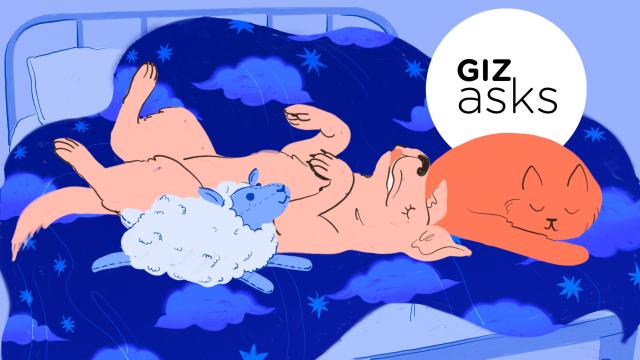An enormous playroom filled with prancing pups, above which are suspended dozens of tubes dispensing treats at a rate of 10 beef-flavored bones per minute. A real adult human who plays tug of war for hours and hours instead of getting bored and giving up after three minutes. A large, comfortable bed that is only for dogs. These are just some of the things that a dog might dream about. But what are dogs actually experiencing while they sleep? Or not even just dogs — what about other pets and animals in general? For this week’s Giz Asks, we reached out to a number of experts to find out.
Kenneth Britten
Professor Emeritus, Neurobiology, Physiology and Behaviour, UC Davis
Rats apparently dream of running through mazes, since recordings of activity in their hippocampus replay sequences observed as they ran the day before (this according to Matt Wilson’s work from MIT, replicated many times). But of course you can’t ask them to know. And birds apparently dream of singing, since activity in their song-control structures does a similar thing (as demonstrated by Dan Margoliash at the University of Chicago). In both cases, the activity is running several times faster than the waking patterns.
These were both done with invasive recording methods, and I know one person who tried to do it non-invasively using fMRI in human subjects. He (Jack Gallant, Berkeley) failed, and never continued that line of work. No surprise, since there’s good reason to believe that blood flow in the brain is quite different during sleep.
Katherine A. Houpt
Professor Emeritus, Behaviour Medicine, Cornell University College of Veterinary Medicine
From what we can tell, cats and dogs tend to be running in their dreams — sometimes you actually see their legs moving. Many also seem to have aggressive dreams. When we see muscle activity that is not usually present during sleep, it suggests they’re acting pretty aggressively in their dreams — so, chasing other cats or dogs, hunting or fighting. Horses tend to run in their sleep — you can sometimes actually see their legs moving. But remember, let sleeping dogs lie, because if they’re dreaming about a fight and you wake them up in the middle of it you may get bitten.
Matthew A. Wilson
Professor, Neurobiology, MIT
I study sleep and dreams in animals. We’ve done a lot of work on rats, trying to figure out what they’re dreaming about. To do this, we first record brain activity when rats are awake and navigating mazes or other environments. Then, when they’re sleeping, we try to determine whether the same patterns reoccur. When you look at a picture, a specific pattern of brain activity emerges; if we see that pattern in your sleep, it would suggest that you’re seeing that picture in your dreams. What we’ve found, in rats, is that they do reoccur. It seems they dream about running around in the spaces they ran around in during the day.
There are two different types of sleep states: rapid eye movement sleep, which is where the fantastical stuff we associate with dreams happens, and non-REM sleep, which is an older, more primitive kind of sleep that’s shared by all animals, even flies. In the non-REM dream state, we see rats recapitulating the stuff that they did during the day. This is similar to humans, whose non-REM dream content also seems to reflect recent experience. It’s more mundane — you might dream of sorting the mail, or making a cup of coffee.
But basically all mammals — rats, dogs, cats — also have REM sleep. And it’s during REM sleep that we take experience and reshape it in novel ways. In REM sleep, we’re able to imagine things and make unusual connections. Rat dreams during REM sleep display content leaps from one point to another — kind of teleportations, say, between different parts of a maze. Dogs, meanwhile, might transport themselves from the couch to the beach. These environments might be connected by an emotional drive — putting together things you like or don’t like, trying to understand, for instance, why your owner gets mad when you jump on the couch.
Let’s say you’re a dog, and your owner is trying to teach you to sit. During non-REM sleep, you might run through the positive associations you’ve formed — i.e., if I sit, I get a treat. Or they might think about when they ran after a ball earlier in the day. Then in REM sleep you’d synthesise that; you’d think, what is it my owner really wants? How can I have a good relationship with him? You imagine things that might occur — what would happen, for instance, if you rolled over on your belly?
What is the purpose of all this dreaming? In non-REM sleep, it’s to sort through the information you’ve accumulated in a given day and figure out what’s important. Then — having assembled a simple model of how the world works — in REM sleep you test that model out.
I think the interesting question is why we — meaning dogs, rats, humans, etc. — dream. I don’t believe that dreams are random. They have a purpose; something important goes on there, and it relates in some way to really understanding how the world works. I’d like to think that as a result of dreaming, humans and animals come to a greater understanding of the larger world they live in.
